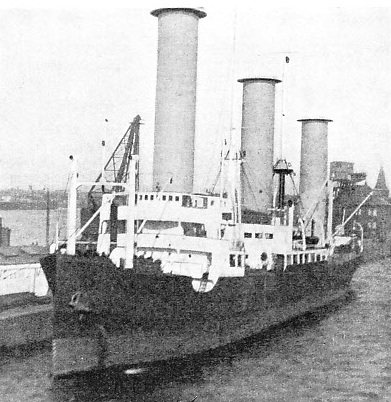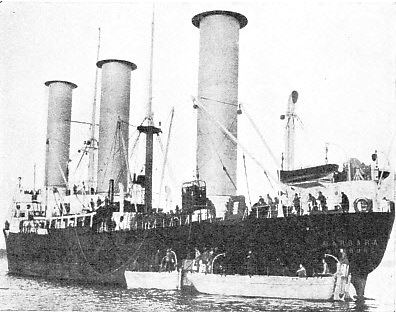

© Shipping Wonders of the World 2012-

Rotor Ships
Why the application of the rotor to ship propulsion, after having proved satisfactory, did not remain long upon the high seas
THE slump which inevitably followed the shipping boom in the war of 1914-
So the years which immediately followed the war were particularly favourable for revolutionary changes in shipping material, and there was still plenty of capital available for experiment. Perhaps the most interesting experiment was the rotor ship. In this an attempt was made to revive the prospects of sail, the oldest method of ship propulsion, by the latest theory of aero-
The rotor ship was introduced to the public in 1924 and immediately captured the popular imagination, perhaps because the tall rotor towers were something visible, as were the paddle-
The inventor was Herr Anton Flettner, a young German who had already made a big reputation for himself among engineers and scientists in his own country. (The times were not propitious for reputations to cross borders.) As a boy of seventeen he had made a voyage to Australia in a sailing ship and had become interested in sail. As a young engineer in the Zeppelin Works he had made a close practical study of aero-

ROTOR TOWERS. Herr Anton Flettner’s idea was to use rotor towers as a substitute for sails in coasting vessels. His object was to take better advantage of the wind as an auxiliary to a ship’s engines, and thus obtain higher speeds with the same horse-
Flettner began with metal sails, much smaller and handier than the ordinary canvas ones, and carefully balanced and shaped to conform with his experience with rudders and the air. In attempting to work out this problem he studied deeply, drawing not only from his own experience, but also from those of his predecessors. The Magnus principle of the effect of wind on violently rotating bodies was one of those which received his attention. This principle had originally been worked out in connexion with artillery, but it had recently been more closely studied in association with the force of wind on aeroplane wings which tends to lift at right angles to its direction.
After much difficulty Flettner secured the necessary backing. In 1924 he converted to his ideas the little schooner Buckau, a vessel of 455 tons gross which had been built in 1920. Her small hull appeared to be hopelessly overbalanced by the two towers, 9 feet in diameter, with a height of 50 feet above the deck. These were rotated at a speed of 140 revolutions a minute by a small motor of 45 horse-
It will be noticed -
The rotor towers were a substitute for sail. Their object was to take advantage of the wind as an auxiliary to the engines and to permit greater speed with the same horse-
Making full use of the Magnus principle, the towers of thin steel, quite light in spite of their bulky appearance, and no danger to the ship’s stability, were rotated, clockwise or anti-

THE ROTOR TOWERS of the Barbara were of an aluminium alloy. Each rotor was 55 feet high with a diameter of about 13 feet. The air surface of the rotor was 2,196 square feet. On her trials the Barbara made 6 knots in a fair wind with rotors only, 9 knots with motors only, and 10½ knots with both. Later the rotors were made to give the engines more assistance, bringing the ship’s speed up to 13 knots.
Unfortunately, when the little Buckau, with her ungainly towers, carried out trials in German waters and then crossed the North Sea in winter with a full cargo of timber, she immediately attracted popular attention and was hailed as being nearly as great a revolution in ship design as the first steamer. She was a pioneer and she was also a makeshift conversion, so that much had to be forgiven her. Yet she had shown remarkably good results. She was absolutely reliable and seaworthy, but there was little possibility of studying costs. Later she was renamed Baden-
In the meantime the German Admiralty had become keenly interested in the principle, not with the idea of fixing huge rotor towers on the decks of battleships, which would, of course, have been absurd, but because of the wider scientific principles involved.
It was the naval authorities who gave orders for the construction of the Barbara, the first rotor ship to be designed as such from the beginning, although she was run on the fruit service of the Sloman Line. She was built by the Weser Yard of Bremen, which had already turned out a number of normal cargo motor ships to the same dimensions and hull design. She was a single-
The Barbara was fitted with three rotor towers instead of two, as in the Buckau. The rotor towers were made of “Lauta” metal, an aluminium alloy with the strength of steel. Each rotor was 55 feet high with a diameter of about 13 feet, the rotating part weighing about one and a half tons. The total air surface of these rotors was 2,196 sq. ft., and they were driven by geared electric motors at a speed which was easily controlled from the bridge, the maximum being 160 revolutions a minute.
Matched with a Motor Ship
The success of the rotor ship depends on the towers revolving at a speed which bears a definite relationship to the wind velocity.
On the first trials of the Barbara, before her designers had had any experience, she made 6 knots with the rotors only, in a fair wind, 9 knots with the motors only, and 10½ knots with motors and rotors together. After a little experience with their adjustment she could easily contrive 13 knots with both running. This was reckoned to be an extra three knots due to the rotors, with an engine of 60 horse-
The result of her first five voyages was published. It was reported that the rotors had been used with full advantage for about twenty-
The Baden-
The principle had so much to recommend it that it was championed by many unskilled advocates, who were attracted by its superficial advantages but ignorant of the limitations of the principles involved. It is unfortunate that the wide publicity obtained by the invention led the public to expect things which the inventor knew to be impossible. Some day, perhaps, the rotor may come into its own again.
You can read more about “How the Modern Ship is Tested”, “Novelties in Ship Design” and “Propelling the Modern Ship” on this website,